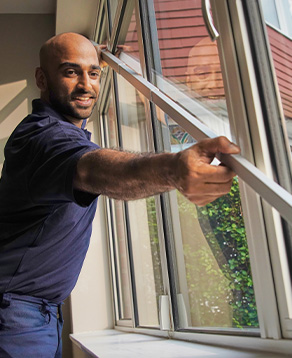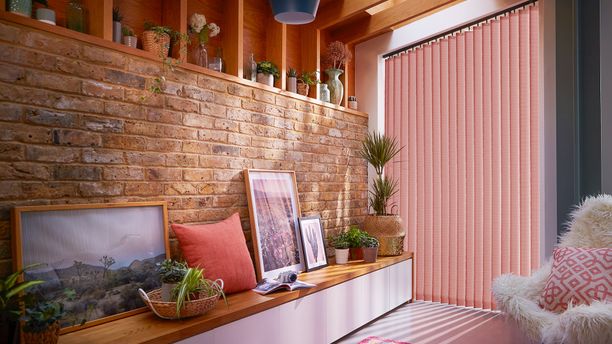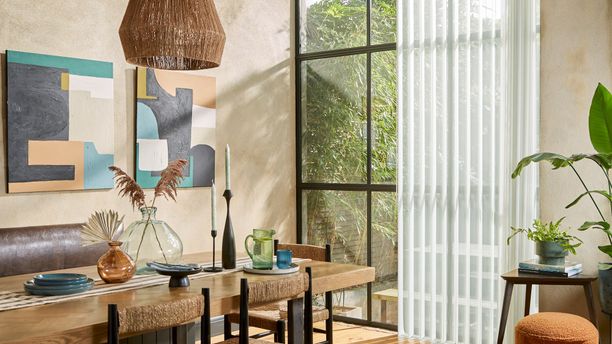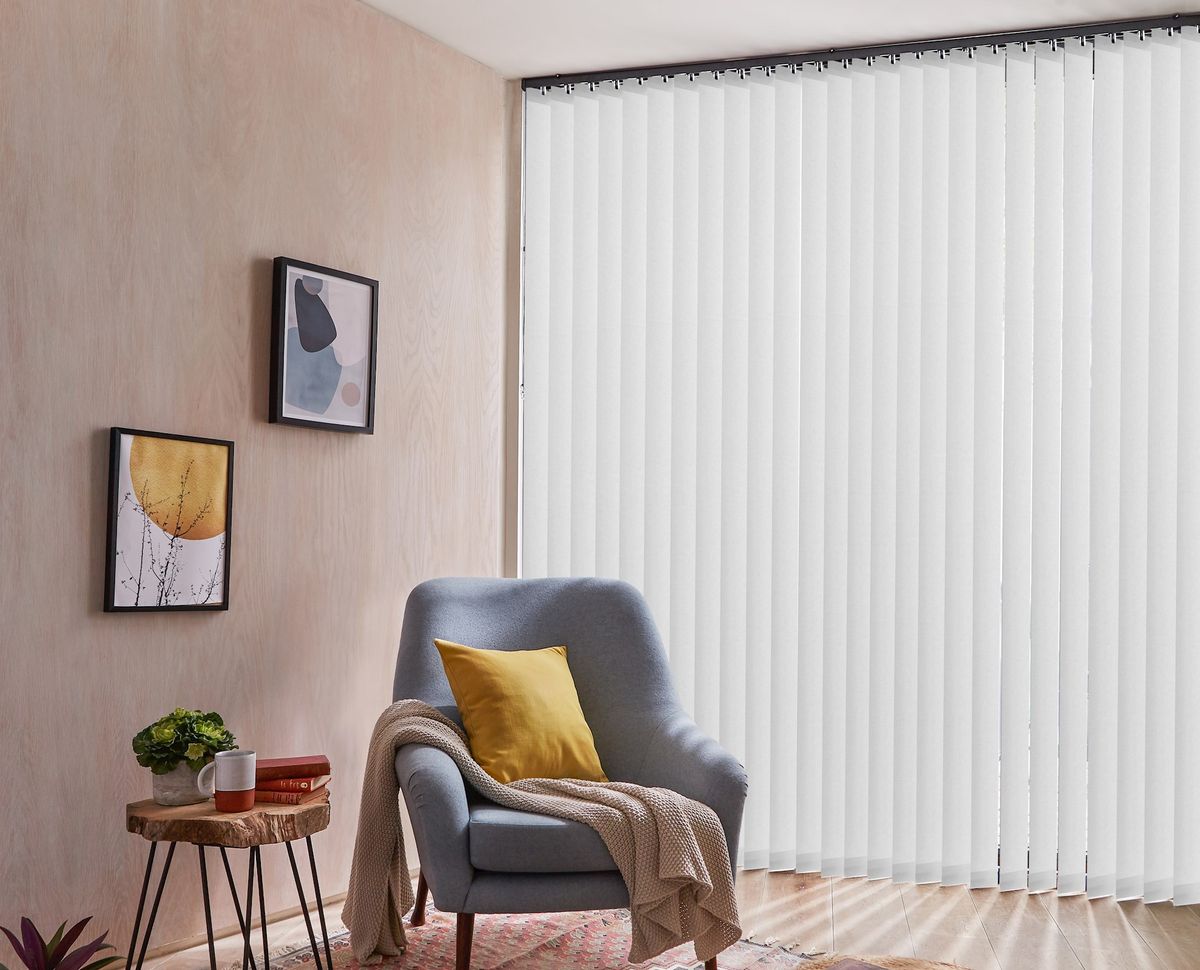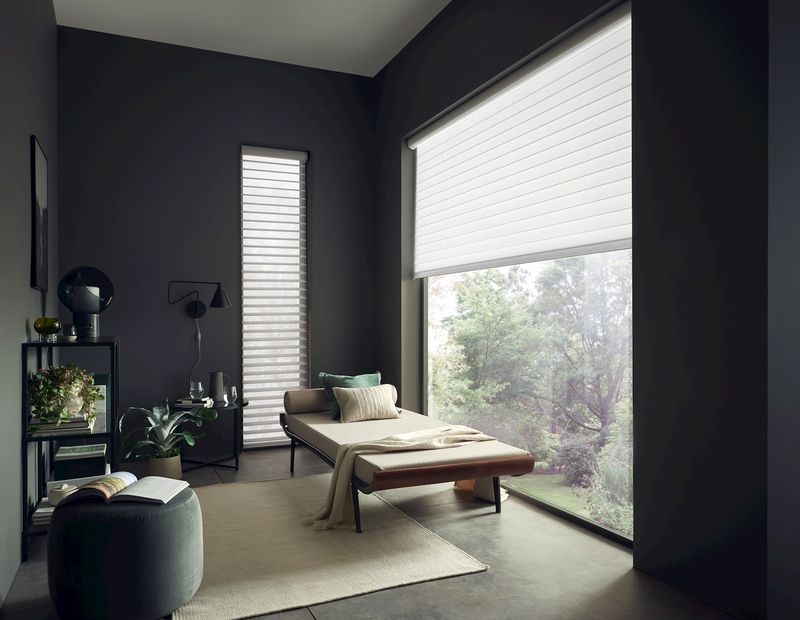Diffused blinds are a fabulous solution for this sun-facing living area, letting in just the right amount of softly filtered light. They also offer privacy control, helping you feel truly comfortable in your space.
Sunlit White
Statement making tables
A sleek Vertical blind is the perfect way to frame this tall living room window, letting you gently filter incoming natural light while keeping your privacy. Subtle yet tasteful Christmas decorations are thoughtfully placed, adding a touch of seasonal delight.
We've added a sheer Diffused blind to this dining space, which has created a beautifully light and airy feel to the room by softly filtering in the natural light while maintaining privacy from the outside world.
Moonlit Light Grey
Inject a sense of calm into your home
The light grey metallic colour of the Reber Silver Vertical blind injects a sense of calm into this neutral decor, and this style of blinds allows you to control the amount of light that comes in to your room. Prices for the Value Collection start at only £55, including measuring, fitting and a professional in-home service.
Reber Silver
Statement making tables
From contemporary and colourful to sparkling Scandi, there are so many ways to dress a dining table for Christmas Day. Begin with a tablecloth or runner, then work in extra textures and colours with foliage, crockery and accessories. Here, the soft Vertical blinds dressing the patio doors complement the contemporary design of this Christmas table beautifully.
Harriet Mink
All the freedom of Vertical blinds
Vertical blinds are a good solution if you have large full-length glazing, like sliding or bi-fold doors. They's great for controlling the light as well as providing privacy. If you need to manage strong sunlight, the louvres can be re-positioned throughout the day to manipulate the light. And when it’s dark outside, you can semi or fully close them to obscure the view into your room. When you want to open the door and go outside, the blind can be pulled right out of the way.
Tresco Dark Ocean
Wise words from a Hillarys advisor
"Why make do when I can do it for you?
Don’t put up with sloping blinds, or curtains that aren’t quite long enough. I'll take care of the measuring and fitting so you don’t have to! I'll visit you at home, show you our full range of products, and help you find the right solution for your home."
Wise words from a Hillarys advisor
"Shades can really help transform the look and feel of a room. I can help you find the exact colour you're looking for, whether you want to match your vertical blinds to your furniture, your wallpaper, or even a favourite ornament."
Stratford Cream
Fleck Seashell Vertical blind
A subtly textured fabric in a neutral shade complements this contemporary bedroom and doesn't overwhelm the room, allowing the super snuggly bed to take centre stage.
Fleck Seashell
Natasha Cox
Customer
Friendly, efficient, good price, very happy
Alessio Darkness
This contemporary marble print is super practical as well as effortlessly stylish. Made from rigid PVC, the louvres are water resistant and easy to clean, making them ideal for steamy bathrooms.
Alessio Darkness
Chris O'Neill
Hillarys Quality Manager
Everything's guaranteed. All of our products are covered by a 12 month warranty.
Iowa Frost
Kitchens are high usage areas where muddy footprints and sticky fingers call for a functional, hardwearing performance product. Our verticals make great kitchen blinds as they filter light beautifully but are also hardwearing and robust.
Iowa Frost
Fergus Grey
Vertical blinds offer great control over light and privacy, making them ideal for home offices and study rooms.
Fergus Grey
Gail
Customer
Love the blind. Great choice and quality at a good price. Excellent service and great communication throughout. Fitted quickly. Will use again.
Acacia Ice
For those who are looking for a truly coordinated look in their home, the Acacia range is simply perfect. The Vertical louvres match shades in our Roller blinds collection, making them perfect for rooms with a mixture of different windows and doors. Combining the blind types together creates a sleek effect.
Acacia Ice
Linara White
Made from multiple louvres, Vertical blinds can be made to fit almost any space - including wide expanses of glass such as sliding and bi-fold doors.
Linara White
Hillarys top tips
You'll love what we do
Our vertical blinds are available in wide widths, so they're perfect for large windows.
Edra Gold
This timeless floral design is dainty and delightful. All our Vertical blinds are available with a curved head rail to accommodate curved bay windows.
Edra Gold
Jane Byrne
Customer
Great price. Fabulous quality. Brilliant overall service.
Edison Light Blue
Contemporary geometric prints and chainless weights create a streamlined, modern look.
Edison Light Blue
